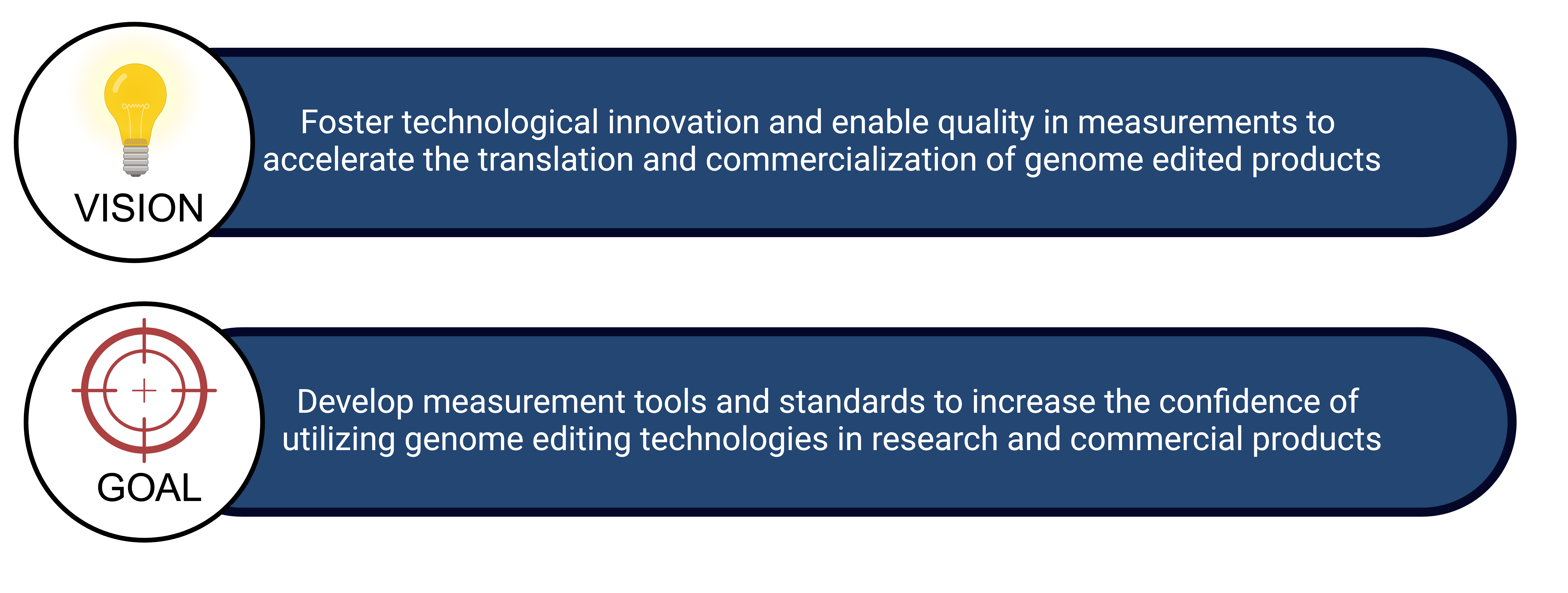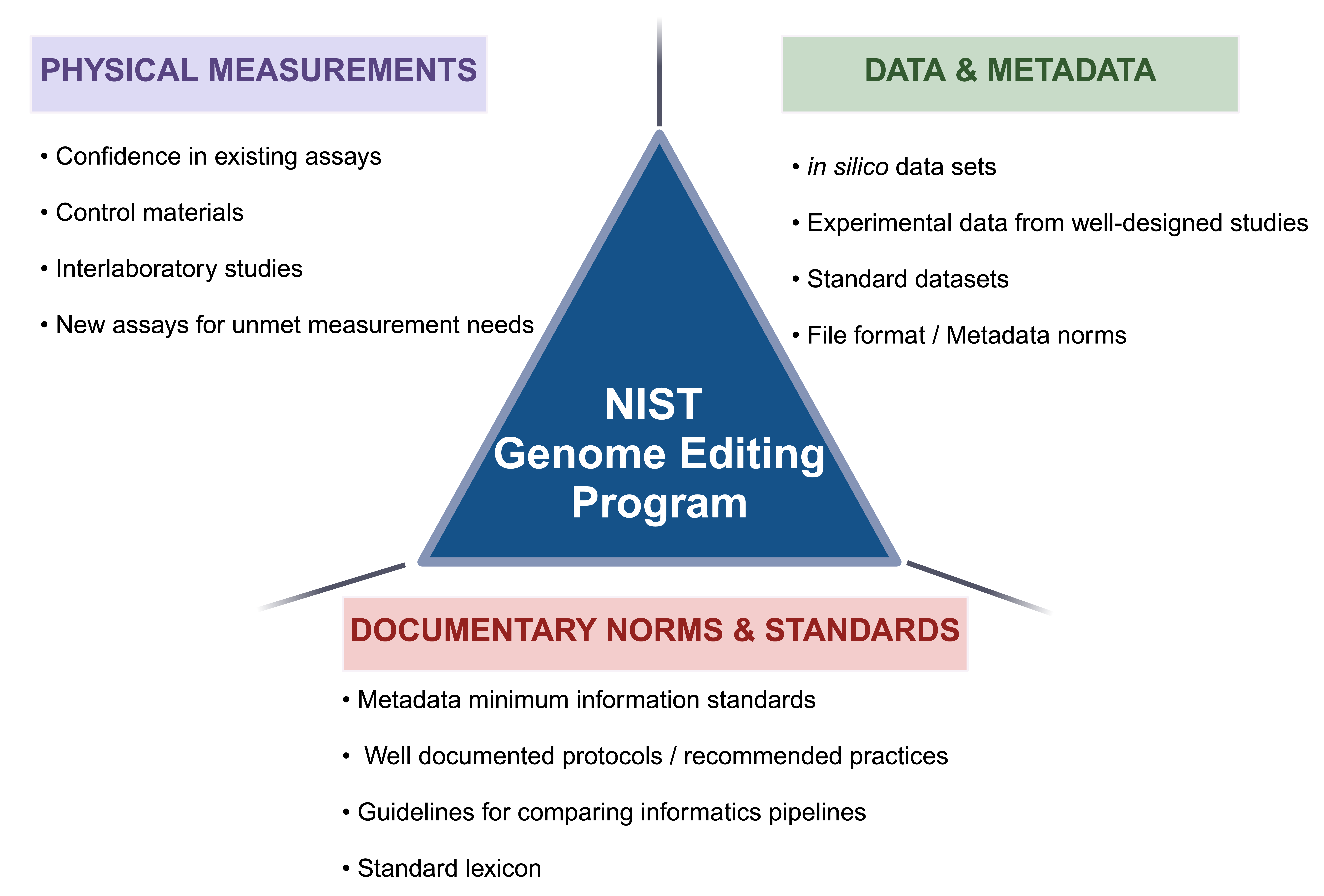Summary
Genome Editing technologies have transformed the potential of biosciences and biotechnology by providing precision engineering tools that enable modifications to be made at specified positions within the genetic code of living cells. This rapidly evolving technology area is being adopted to advance many sectors of the bioeconomy including: human health (eg., cell and gene therapies, microbial-based diagnostics and therapeutics), agriculture, engineering/synthetic biology, environment, and biomanufacturing.
The NIST Genome Editing Program develops standards, methods, tools, technology, and community norms to advance the reliability of genome editing technology and foster confidence in measurements for the genome editing field.

Description
For genome editing systems to reach their full potential in research and commercial products, new measurement tools, capabilities, and standards must be developed to efficiently implement and assess the performance of these editing technologies, as well as to evaluate the utility of resulting products (e.g., engineered cells) for their intended purposes.
The NIST Genome Editing Program actively supports this growing industry by:
NIST GENOME EDITING PROGRAM FOCUS AREAS
The NIST Genome Editing Program is focused on three primary areas: 1) Physical Measurements, 2) Data & Metadata, and 3) Documentary Norms and Standards.

NIST GENOME EDITING CONSORTIUM
The NIST Genome Editing Consortium is a public-private partnership with genome editing stakeholders to define measurement challenges for utilizing existing measurement capabilities to understand genome editing outcomes and develop shared solutions.
QUALIFICATION OF ASSAYS FOR DETECTING GENOME WIDE OFF-TARGET ACTIVITY OF GENOME EDITING MOLECULES
NIST is working closely with technology developers and other federal agencies to apply measurement assurance (including bioinformatics), associated tools, and well-documented protocols to improve reliability and reproducibility of recently developed assays for detecting off-target activity of genome editing molecules.
Project Collaborators and Assays:
CHANGE-seq
- NIH Somatic Cell Genome Editing (SCGE) Common Fund Program
- St. Jude Children’s Research Hospital, Lab of Shengdar Tsai, PhD
GUIDE-seq2
- NIH Somatic Cell Genome Editing (SCGE) Common Fund Program
- St. Jude Children’s Research Hospital, Lab of Shengdar Tsai, PhD
INDUCE-seq
- Health and Environmental Sciences Institute (HESI)
- Novartis
- AstraZeneca
- BrokenStrings Biosciences
- TwinStrand Biosciences
ONE-seq
- DARPA SafeGenes Program
- Massachusetts General Hospital, Lab of J. Keith Joung, MD/PhD
- SeQure Dx
SITE-seq
- FDA Center for Veterinary Medicine (CVM)
- Caribou Biosciences
Development AND Qualification of Positive CONTROLS for Genome editing in pig and cattle cells
Genome editing is being used within the agricultural field to enhance food produc
NIST, in collaboration with the FDA Center for Veterinary Medicine (CVM), is working to ensure the safety and efficacy of genome edited animal biotechnology products.
ASSESSMENT OF GENOME EDITING REAGENTS & TECHNOLOGIES
Genome editing molecules to be introduced into a cell and/or organism can be formulated in various formats including: DNA, short RNA (in vitro transcribed and synthetic with or without modifications), mRNA, and protein. Additionally, there are several options for technologies to physically deliver genome editing molecules into cells and/or organisms. The NIST Genome Editing Program is actively assessing strategies for evaluating the properties, capabilities, and limitations of different genome editing molecule formulations as well as approaches for delivering genome editing molecules into cells.
Genome editing molecule delivery platforms under evaluation:
- FluidFM OMNIUM (Cytosurge AG)
- Neon (ThermoFisher)
- Nucleofector 4D (Lonza)
Any mention of commercial products within NIST web pages is for information only; it does not imply recommendation or endorsement by NIST.
PUBLICATIONS
- CHANGE-seq reveals genetic and epigenetic effects on CRISPR–Cas9 genome-wide activity
- The NIH Somatic Cell Genome Editing program
- Measurement and standardization challenges for extracellular vesicle therapeutic delivery vectors
- Fire Burn and Cauldron Bubble: What Is in Your Genome Editing Brew?
- Variability in genome-engineering source materials: consider your starting point
RELATED NEWS
- Spotlight on Commerce: Samantha Maragh, Ph.D., Leader of the Genome Editing Program, National Institute of Standards and Technology (NIST)
- Setting standards in the CRISPR genome editing revolution. Interview: Samantha Maragh (NIST)
- Rewritten in Our DNA: Measurements for Genome Editing
- 2021 GEORGE A. URIANO AWARD: Samantha Maragh

